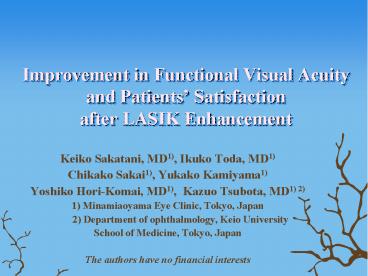Improvement in Functional Visual Acuity and Patients - PowerPoint PPT Presentation
Title:
Improvement in Functional Visual Acuity and Patients
Description:
Keiko Sakatani, MD1), Ikuko Toda, MD1) Chikako Sakai1), Yukako Kamiyama1) Yoshiko Hori-Komai, MD1), Kazuo Tsubota, MD1) 2) 1) Minamiaoyama Eye Clinic, Tokyo, Japan ... – PowerPoint PPT presentation
Number of Views:153
Avg rating:3.0/5.0
Title: Improvement in Functional Visual Acuity and Patients
1
Improvement in Functional Visual Acuity and
Patients Satisfaction after LASIK Enhancement
- Keiko Sakatani, MD1), Ikuko Toda, MD1)
- Chikako Sakai1), Yukako Kamiyama1)
- Yoshiko Hori-Komai, MD1), Kazuo Tsubota, MD1) 2)
- 1) Minamiaoyama Eye Clinic, Tokyo, Japan
- 2) Department of ophthalmology, Keio
University - School of Medicine, Tokyo, Japan
- The authors have no financial interests
2
Purpose
- Patients who undergo LASIK sometimes complain of
blurred vision and desire LASIK enhancement even
when their uncorrected visual acuity (UCVA) is
20/20 or better. - To investigate the reasons which may be
associated with the patients satisfaction for
the outcomes of refractive surgery using a
comparison of dissatisfied patients with
satisfied patients who had the same levels of
UCVA and spherical equivalence (SE). - To determine the efficacy of LASIK enhancement
for patients with complaints of their visual
performance after initial LASIK.
3
Patients and Methods
- We retrospectively analyzed 9 eyes of 5 patients
who were dissatisfied after LASIK at Minamiaoyama
Eye Clinic due to blurred vision, although their
UCVA was 20/20 or better and they underwent LASIK
enhancement (dissatisfied group) . - We also analyzed 11 eyes of 8 patients who were
satisfied with the outcomes and had corresponding
levels of UCVA and SE with the dissatisfied group
(satisfied group). - The functional visual acuity (FVA) was measured
continuously for 60 seconds in a blink-allowed
period using the FVA measurement system (Nidek,
Aichi, Japan).
4
Functional Visual Acuity (1)
The FVA measurement system is made up of three
parts hard disc, monitor and joystick. The
Landolt rings are presented on the monitor,
and their sizes change depending on the
correctness of the responses. The optotype is
displayed starting with smaller one which the
patient can recognize correctly (equal to UCVA).
If the response is incorrect, a larger optotype
is presented automatically. When there is no
response within the set display times, the
answer is taken to be an error and the optotype
automatically enlarges.
5
Functional Visual Acuity (2)
The results of FVA is displayed as follows
FVA is calculated as a line which equalizes the
area of gray and black after a 60-second test.
The timing and number of blinks are observed and
recorded by an examiner. While conventional
visual acuity measures a maximum visual ability,
FVA stands for a daily visual performance.
Decimal VA/ LogMAR
?Blink
Starting VA
FVA
6
Comparison of
Dissatisfied with Satisfied Patients
Dissatisfied group Satisfied group U-test
Age 36.1 30.8 0.079
UCVA (logMAR) 20/18 (-0.045) 20/17 (-0.082) 0.072
FVA (logMAR) 20/28 (0.150) 20/21 (0.034) 0.043
SE -0.30 -0.28 0.714
BUT 4.0 3.1 0.160
SRI 0.132 0.264 0.084
SAI 0.372 0.581 0.122
HOA 0.643 0.683 0.625
Satisfaction 2 0 0.019
BUTtear-film breakup time
SRIsurface regularity index
SAIsurface asymmetry index
HOAhigher order aberration Satisfaction level
was marked as 0 (very satisfy) to 4 (very
dissatisfy) by patients. There are statistically
significance in FVA and satisfaction between the
2 groups.
7
The Change in UCVA
20/10
20/16
Mean 20/13
20/20
Mean 20/18
20/40
P0.0007
20/100
Before enhancement
3 months after
8
The Change in SE
Diopter
1.0
0.5
Mean 0.17D
0
-0.5
Mean -0.30D
P0.302
-1.0
Before enhancement
3 months after
9
The Change in FVA
20/10
P0.001
20/16
20/20
Mean 20/17
20/40
Mean 20/28
20/100
20/200
3 months after
Before enhancement
10
The Change in Satisfaction
Satisfied
0
1
2
Mean 0.33
3
P0.001
4
Mean 2.33
Dissatisfied
Before enhancement
3 months after
11
The Change in BUT / SAI / SRI / HOA
Before enhancement 3 months after enhancement Wilcoxon test
BUT 4.31.9 3.71.3 0.529
SAI 0.3720.184 0.3860.197 0.802
SRI 0.1320.084 0.1640.171 0.433
HOA 0.6430.183 0.6090.206 0.925
There were no significant differences.
12
Conclusions
- Measurement of FVA seems to more sensitively
assess visual performance than conventional
visual acuity testing. - UCVA, FVA and patients satisfaction were
improved after LASIK enhancement for patients who
were dissatisfied with the outcomes of initial
surgery. - FVA measurement could be useful in determining
patients satisfaction and an indication of
retreatment after refractive surgery.































